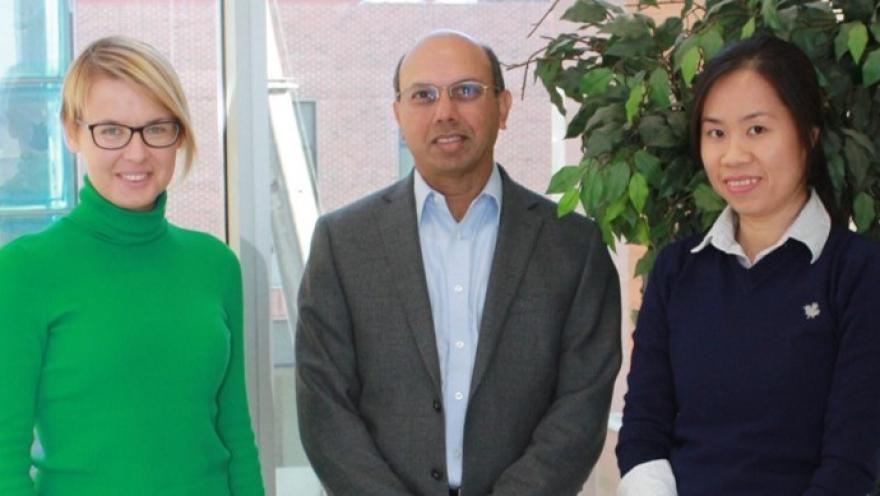Your research donations make a difference! ALS Association-funded Dr. Mervyn Monteiro, Professor at the University of Maryland School of Medicine, developed novel ALS mouse models expressing mutant ubiquilin 2 (UBQLN2), a cause of inherited ALS-FTD that was published this week in the journal Proceedings of the National Academy of Sciences (PNAS). Importantly, these mouse models demonstrate many characteristics of ALS observed in humans, thereby providing valuable tools for identifying disease pathways in ALS and for investigating therapeutic strategies to treat ALS.
Animal models of ALS are important tools for understanding pathways of disease and aid in preclinical investigations to identify therapeutic targets. This is the ultimate goal for developing the UBQLN2 mouse models that Dr. Monteiro, co-first authors Drs. Nhat Le (see above in black), Irina Kovlyagina (see above in green), Lydia Chang, and their colleagues, had in mind.
What is UBQLN2?
Mutations in UBQLN2 were discovered in 2011 to cause ALS with frontotemporal dementia (FTD). The normal function of UBQLN2 is that it acts like a shuttle to bind misfolded proteins that the cell wants to throw out. It then takes the misfolded protein to the cell’s protein recycling machinery – either the proteasome or autophagy systems - for degradation. It is like UBQLN2 throws out the cell’s trash.
There is growing evidence that there is a disruption in the clearance of misfolded proteins from cells in ALS. A failure to remove misfolded proteins can lead to the production of protein aggregates (i.e. clumps of protein that can be toxic to cells) and can cause cell death. The ALS-mutant UBQLN2 proteins are defective in removing misfolded proteins from cells. Consistent with this defect, the mutant UBQLN2 mice displayed an age-dependent accumulation of protein aggregates in the brain and spinal cord (see TDP-43 aggregation section below).
UBQLN2 Mouse Models
Dr. Monteiro and his team created UBQLN2 mouse models by inserting mutant UBQLN2 or normal UBQLN2 into mice. The mice expressing mutant UBQLN2 proteins developed ALS-like disease symptoms similar to those seen in humans, including a progressive decline in muscle strength and limb paralysis. They also had shorter lifespans compared to normal mice or mice expressing the normal UBQLN2 protein. The mutant mice also displayed degeneration of axons, the long extensions of motor neurons that are used to send signals to the muscle. Finally, mice developed cognitive defects in addition to motor dysfunction, which is common in several forms of ALS. By comparison, the mice expressing normal UBQLN2 did not develop these symptoms or disease characteristics.
TDP-43 Aggregation Observed
A remarkable feature of the mutant UBQLN2 mice was the presence of TDP-43 aggregates in their nerve cells. TDP-43 aggregation is seen in 97% of ALS cases, but not all mouse models demonstrate this pathology. Although the significance of TDP-43 aggregation in ALS is not fully understood, many investigators believe it is somehow connected to the cause of motor neuron disease.
In healthy cells, TDP-43 protein normally resides in the nucleus. However, in the cells of ALS patients, TDP-43 is displaced to the cell’s cytoplasm. In the mutant UBQLN2 mouse models, TDP-43 was also displaced to the cytoplasm where it accumulated in aggregates (See Figure 1).
Impact
There is an urgent need for mouse models that not only display the ALS symptoms observed in humans but also show TDP-43 aggregates. Monteiro’s novel UBQLN2 mouse models accomplished just that. These UBQLN2 models will likely help researchers to better understand how defects in protein degradation systems cause ALS and to understand the link between TDP-43 aggregation and motor neuron disease. Together this may lead to novel therapeutic targets and new therapies for ALS.
Accumulation of misfolded proteins is a common factor in multiple neurodegenerative disorders, including ALS, Alzheimer’s disease, Parkinson’s disease, and Huntington’s disease. It is likely that lessons learned in correcting the defects in protein degradation systems using the UBQLN2 mouse models could be applied to all the above diseases, broadening the impact of the models.
What is next?
Now that the UBQLN2 mouse models have been successfully made and characterized by Dr. Monteiro and his team, they will be used to identify the genes and pathways that are specifically altered during ALS disease progression. This knowledge may provide valuable leads in devising rational therapies to treat and cure ALS-FTD. The ALS Association in partnership with The Robert Packard Center for ALS Research at Johns Hopkins University in Baltimore already funded this follow-up project. We look forward to hearing more about Dr. Monteiro’s progress in the future!
Learn more
Read the accompanying press release here.
Dr. Monteiro recently gave a webinar highlighting this study with more detailed information. View his webinar here.
Hear more ALS research topics in The Association’s research webinar series here.
Read Dr. Monteiro's PNAS paper here.


Join the conversation. Please comment below.